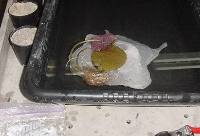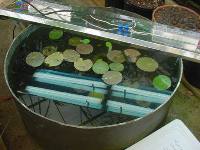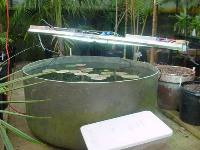|
Photos by Sean Hoelscher Click to enlarge Once Victoria seedlings are "over the hump", that is to say they have made four or more floating leaves, each increasing in size, they are tough enough to send to others. Where we used to go to elaborate lengths to ship them potted, padded and braced, we now ship them bare-root successfully. Safe shipping age begins when seedlings have outgrown their 3 ounce starter cups or have been boosted. We unpot them and gently float the sand and peat away from the roots. We lay them on a wet paper towel and loop the stems all the same direction, stacking the pads like pancakes, face to face and alternately thorns to thorns. We fold the edges of the towel loosely over the plant and cover with another paper towel. This package goes into a ziplock, sometimes several to a bag, with most of the air pressed out. It is important to pack the box they will be shipped in tightly to prevent movement of the plants once inside. Shipping should be over night or, at the most two days and, hopefully, at a time when it is neither too hot nor too cold. We write special instructions on the box. Older plants can be shipped without the paper towels in bigger plastic bags but we still prefer to use some wet newspaper to protect the stems and emerging pads. We always notify recipients when we send plants and provide the estimated day and time of arrival. Early in the season -- Plants should be potted immediately in sand with a small layer of peat in the bottom. Those from 3 ounce cups can usually go into 8 ounce cups with holes or 4" pots with holes. For larger plants we recommend they go into the same size or only slightly larger pots until they recover from shipping and transplant shock. If stems happen to get bent in shipping, they can be massaged back straight. If leaves have discolored or deteriorated in shipping, don't cut them off. For some reason, the leaves curl backwards in shipping but they will flatten back out in a day or two. Try to place the plants in water where the older pads can reach or be within an inch the surface. They can be lowered gradually. After a few days, the plants will need to be fed. We strongly
recommend using our Victoria nutrient "cocktail". Once you have had your plants for a few weeks, you can stall them at their current size by reducing water temperature and/or reducing fertilizer. If you want them to continue to increase in size, you can increase fertilizer proportionally and increase pot size gradually as they become pot bound. You will know the plants are happy when roots begin to grow out the holes. We put a layer of sandy soil on the bottom of trays and tanks for those roots to grow into. Later in the season -- Be sure to check with your supplier to see if the plants have been growing outside or in a greenhouse. Those grown in greenhouses should be screened from the sun for the first few days (ordinary window screen works fine) as Victoria is extremely prone to sunburn when first "coming out". For those that have been growing outside, screening isn't necessary. You will want to have your nutrients on hand. Though we personally continue with Pondtabbs and the "cocktail" for adults, we think that Pondtabbs Plus alone may be suitable for many soils. The plants should be fed weekly based on pad size and number for optimum growth and flowering. If you have turtles, ducks, large koi or crawfish in your pond, you will need to cage your Victorias until they reach adult size. |
 |
|
|
|
 |
|
 |
|
 |
|
 |
|
 |
|
 |
Sean Hoelscher's 2003 Victorias at Atlanta Botanical Garden